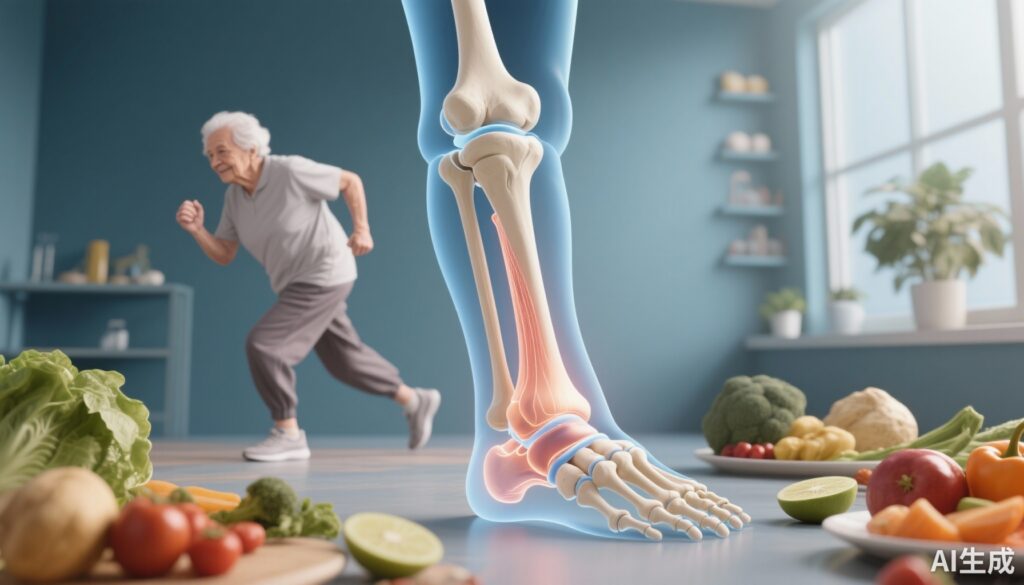Highlight
– Intensive lifestyle interventions involving weight loss plus exercise preserve distal tibia cortical thickness and hip bone strength in older adults with obesity.
– Despite significant weight loss (~11.6 kg over 12 months), no deleterious effects on bone quality were observed compared to usual lifestyle advice.
– The LIMB-Q trial used advanced imaging methods, including high-resolution peripheral quantitative CT and finite element analysis, to assess cortical bone thickness and biomechanical strength.
– Safety profile was acceptable, with few musculoskeletal adverse events reported during exercise training.
Study Background and Disease Burden
Obesity in older adults (65–85 years) is a risk factor for morbidity and mortality, and lifestyle interventions targeting weight loss are broadly recommended to reduce associated cardiometabolic outcomes. However, weight loss in this population may exacerbate age-related bone loss and osteoporosis, increasing fracture risk and severely impacting quality of life and healthcare burden. Traditional bone mineral density (BMD) measurements do not fully capture bone strength or fracture susceptibility, as bone quality—incorporating bone microarchitecture and material properties—is a critical determinant of skeletal fragility. The effects of lifestyle interventions on bone quality remain poorly understood despite their widespread use. The LIMB-Q trial was designed to address this gap by evaluating whether an intensive lifestyle intervention combining weight management and exercise training can preserve or enhance bone quality in older adults with obesity despite reductions in BMD.
Study Design
The LIMB-Q trial was a randomized controlled study conducted at Baylor College of Medicine and the Michael E DeBakey VA Medical Center (Houston, TX, USA). The study enrolled 120 older adults aged 65–85 years with obesity defined by BMI ≥30 kg/m2. Participants were randomized 1:1 to an intensive lifestyle intervention group or a healthy lifestyle control group. The intensive lifestyle group engaged in a comprehensive program involving weight management counseling plus structured exercise training aimed at promoting weight loss and physical fitness. The healthy lifestyle group received educational sessions on healthy diets without prescribed exercise or weight loss interventions.
Co-primary endpoints assessed at baseline and 12 months included distal tibia cortical thickness measured using high-resolution peripheral quantitative computed tomography (HR-pQCT) and hip bone strength quantified by failure load derived through finite element analysis (FEA) of CT scans. The study analyzed outcomes on an intention-to-treat basis.
Key Findings
Of the 138 adults assessed, 120 participants (mean age 71.4 years, SD 4.6; 53% male) completed the baseline evaluation and underwent randomization. At 12 months, the intensive lifestyle group achieved significant weight loss with an average reduction of 11.6 kg (SE 0.5) versus 1.2 kg (SE 0.5) in the healthy lifestyle group.
Regarding bone outcomes:
– Distal tibia cortical thickness decreased minimally and similarly in both groups: -0.013 mm (SE 0.026) in the intensive lifestyle group versus -0.002 mm (SE 0.025) in controls, with no statistically significant difference (between-group difference 0.027 mm; 95% CI -0.066 to 0.120; p=0.40).
– Hip failure load, reflecting bone strength, remained stable with a mean change of +13 N (SE 25) in the intensive lifestyle group and +3 N (SE 26) in controls (between-group difference -6.9 N; 95% CI -108 to 95; p=0.89).
Safety monitoring reported few musculoskeletal adverse events during the intensive lifestyle program, including one participant fall and isolated neck, foot, shoulder, back, and leg pain, each affecting one participant.
These data indicate that the intensive lifestyle intervention, despite inducing substantial weight loss, did not adversely affect bone cortical thickness or biomechanical strength in key skeletal sites over one year.
Expert Commentary
Dr. Dennis Villareal, the lead author, emphasizes that this trial provides compelling evidence that weight loss in older adults with obesity, when combined with structured exercise, can be achieved without compromising bone quality. Given the limitations of BMD alone in capturing fracture risk, the use of sensitive imaging modalities such as HR-pQCT and finite element analysis was instrumental in elucidating these findings.
The absence of significant deterioration in bone cortical thickness or hip failure load suggests that rigorous lifestyle modification may protect skeletal integrity, possibly through mechanical loading during exercise that counterbalances bone resorption associated with weight loss.
However, limitations include the relatively short duration (12 months) and the exclusion of participants with severe osteoporosis or recent fractures, which restricts extrapolation to higher-risk populations. Larger and longer-term studies integrating clinical fracture outcomes are warranted to confirm whether these benefits translate into reduced fracture incidence.
Conclusion
The LIMB-Q trial offers important clinical insights: intensive lifestyle interventions combining weight loss and exercise preserve bone quality in older adults with obesity, countering concerns that such interventions might exacerbate osteoporosis. These findings support the incorporation of exercise in weight management strategies for this population to mitigate potential bone loss.
Further research should explore long-term effects on fracture risk, optimize exercise modalities and intensities, and evaluate integrative approaches including pharmacotherapy for fracture prevention. Meanwhile, clinicians should consider recommending comprehensive lifestyle interventions that emphasize both weight control and physical activity to promote musculoskeletal health in elderly obese patients.
References
1. Gregori G, Mediwala S, Liebschner M, Kim D, Bryant MS, Klonis N, Armamento-Villareal R, Qualls C, Villareal DT. Bone quality response to lifestyle intervention in older adults with obesity (LIMB-Q trial): a randomised controlled trial. Lancet Healthy Longev. 2026 Sep 30:100761. doi: 10.1016/j.lanhl.2025.100761. Epub ahead of print. PMID: 40976254.
2. Villareal DT, Chode S, Parimi N, Sinacore DR, Hilton TN, Armamento-Villareal R et al. Weight loss, exercise, or both and physical function in obese older adults. N Engl J Med. 2011 Feb 3;364(13):1218-29.
3. Khosla S, et al. Bone quality: an important determinant of bone strength and fracture risk. J Bone Metab. 2015 Mar;22(1):7-18.
4. NIH Consensus Development Panel on Osteoporosis Prevention, Diagnosis, and Therapy. JAMA. 2001;285:785-95.


